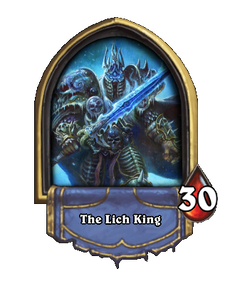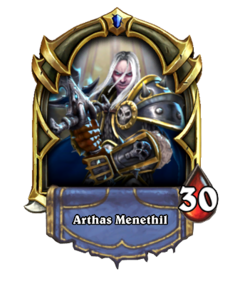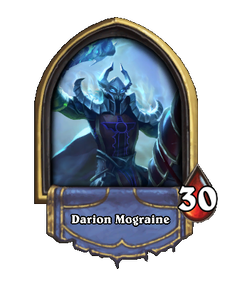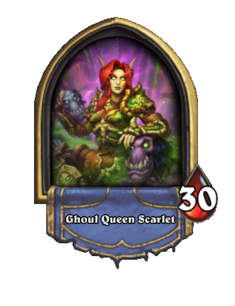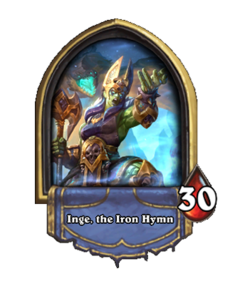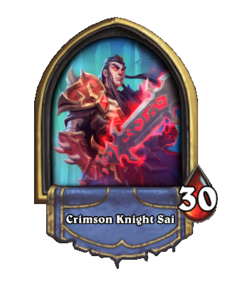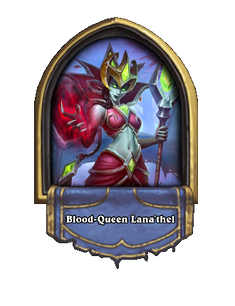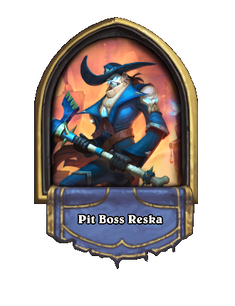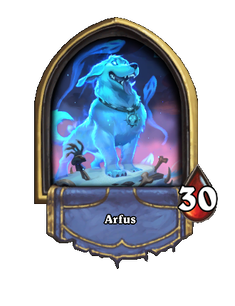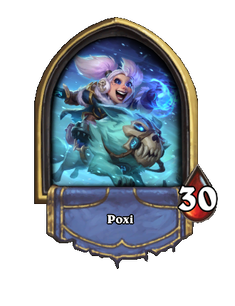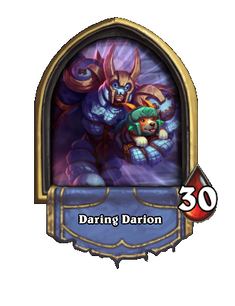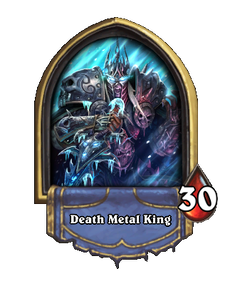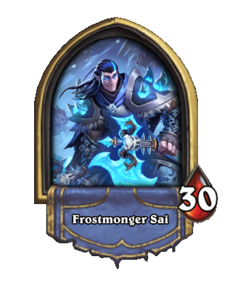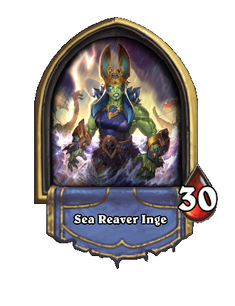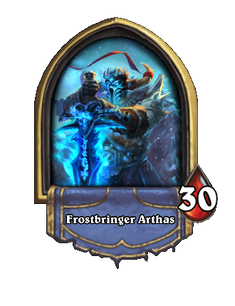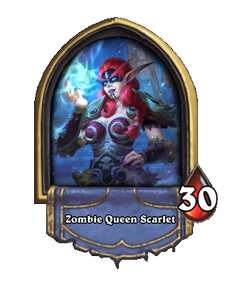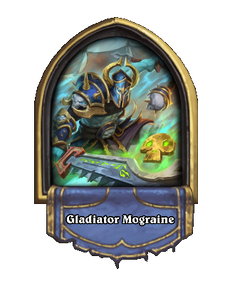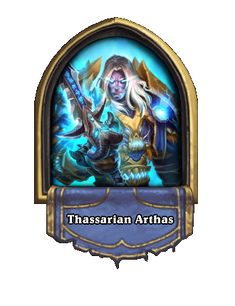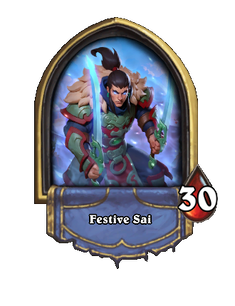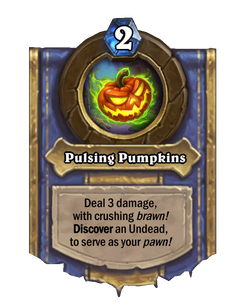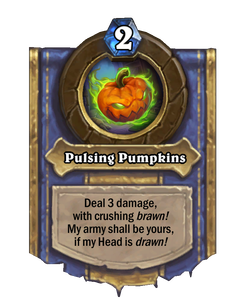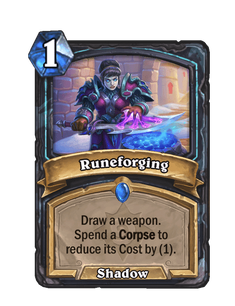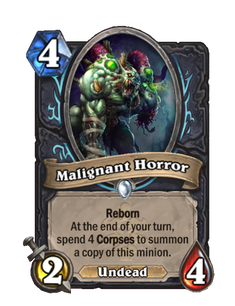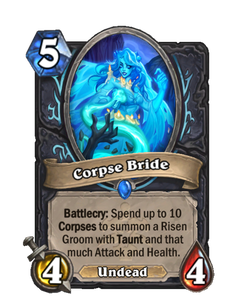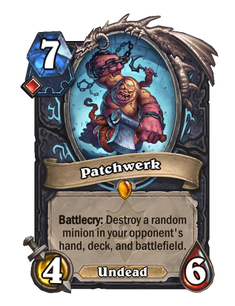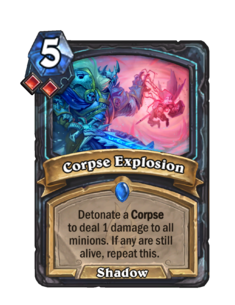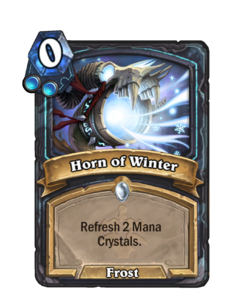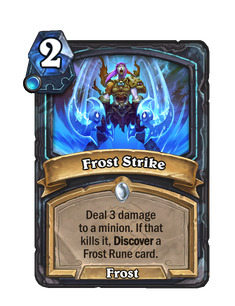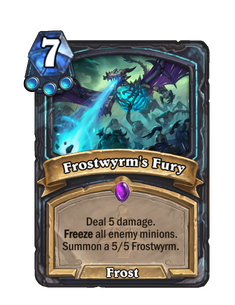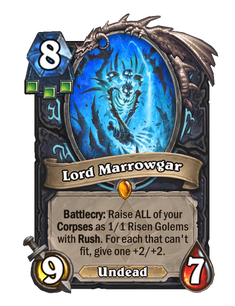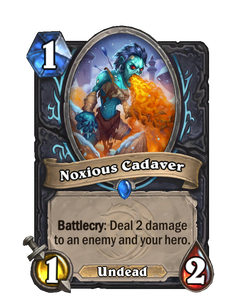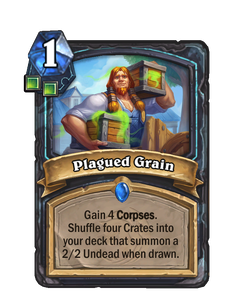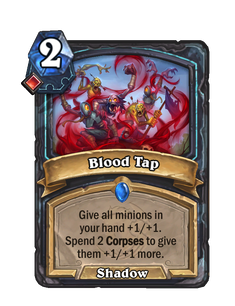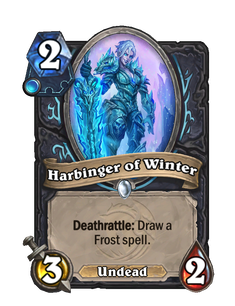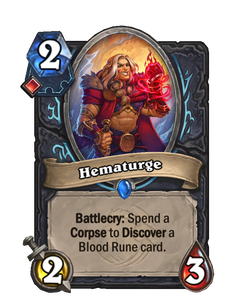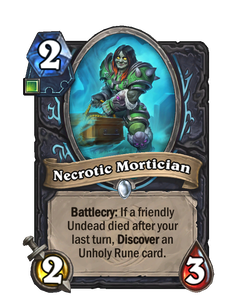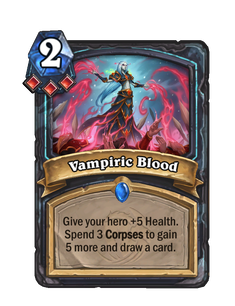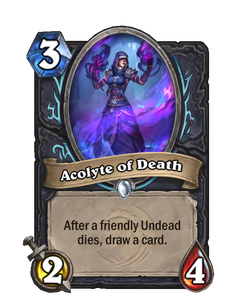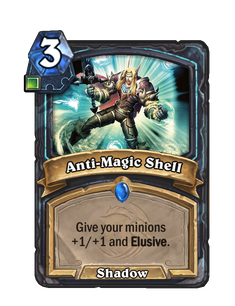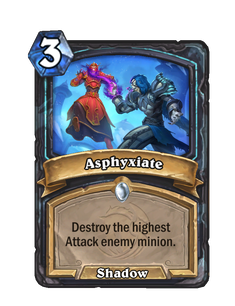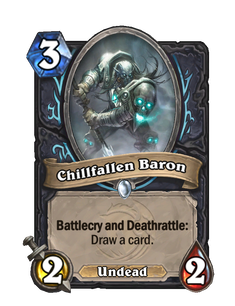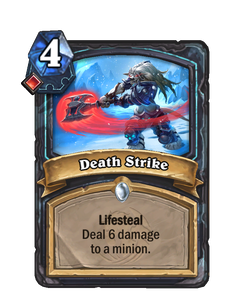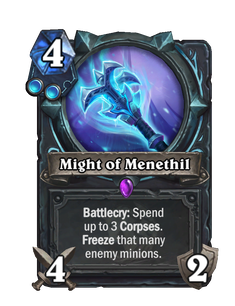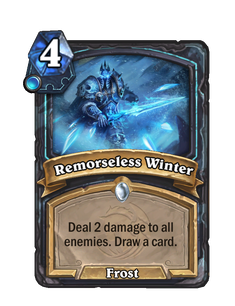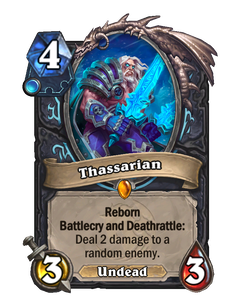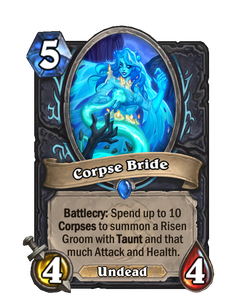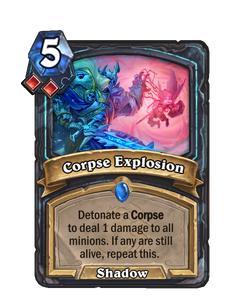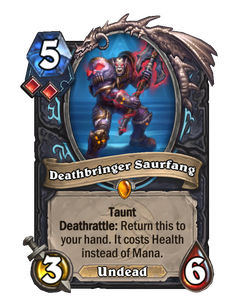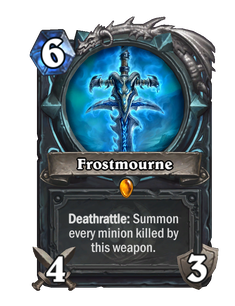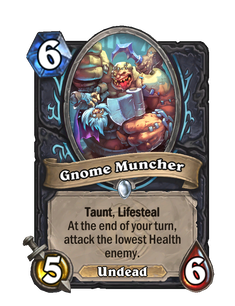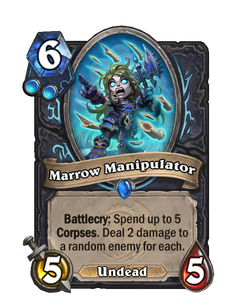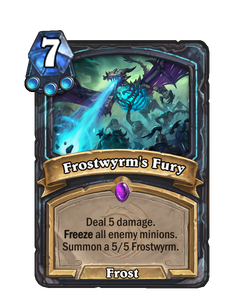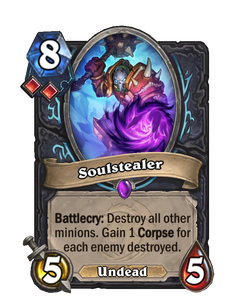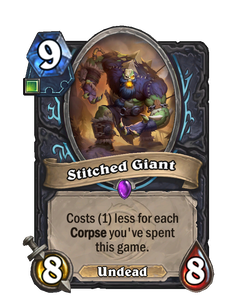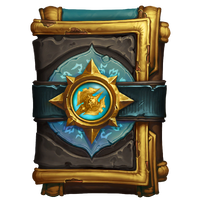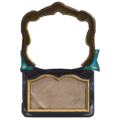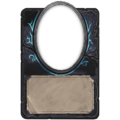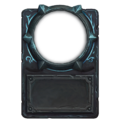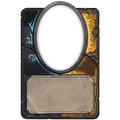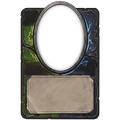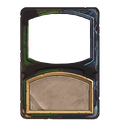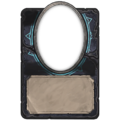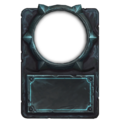Death Knight
- Death Knights are a diverse class that can harness the powers of Blood, Frost, and the Undead to devastating effects. They also have a unique class mechanic and special deck building rules. Master them all as you prepare to make the most out of your Undead army![1]
![]() Death Knight is one of 11 classes in Hearthstone.
Death Knight is one of 11 classes in Hearthstone.
Heroes[edit | edit source]
Death Knight is represented by the following heroes. The Lich King is the default hero of Death Knight.
- Heroes
- Alternate portraits
Background[edit | edit source]
- Main article: Death Knight
When the Lich King’s control of his death knights was broken, his former champions sought revenge for the horrors committed under his command. After their vengeance was won, the death knights found themselves without a cause and without a home. One by one they trickled into the land of the living in search of a new purpose. Frost sharpens their strikes; blood fortifies their bodies; and undeath allows them to erupt in unholy rage in the heat of battle. A thousand atrocities are etched in the eyes of every death knight, and foes who gaze into them too long will feel the warmth pulled from their bodies, replaced with cold steel.[2]
Hero Power[edit | edit source]
- Main article:
Ghoul Charge
- Use it or lose it—the shambling Ghoul falls apart at the end of your turn. Luckily, Death Knights can make good use of minions that die in combat...[1]
Ghoul Charge, the class' Hero Power, is a two-mana minion-based small damage output that must be used on the same turn. It fits well with death knight's unique mechanic, Corpses, and the general theme of minion deaths.
The hero power summons Frail Ghoul, an Undead minion which can also be used for different Undead synergies.
Replacement Hero Powers[edit | edit source]
Ghoul Frenzy is the upgraded Hero Power of
Ghoul Charge.
The Headless Horseman will replace the current Hero Power with
Pulsing Pumpkins, as well as replace the hero. After drawing
Horseman's Head, the Hero Power becomes
Pulsing Pumpkins.
Traits[edit | edit source]
Corpses[edit | edit source]
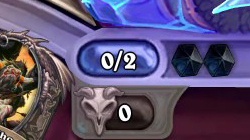
- Main article: Corpse
- Whenever a friendly minion dies, the Death Knight gains a Corpse. This special, class-specific resource can then be used to fuel and power up some of your cards. Each friendly minion leaves a Corpse behind, including minions you play, minions you summon with other cards, minions that are resummoned through the returning Reborn keyword, and the Ghouls summoned by your hero power![1]
Death Knight introduces a new class-specific secondary resource and mechanic, Corpse. While playing as death knight, each friendly minion produces a Corpse that increments the Corpse counter under the player's mana crystals. Many cards then spend these Corpses to produce powerful effects.
- Featured cards
Runes[edit | edit source]
- Main article: Rune
You may have noticed the colored symbols around the mana costs of some Death Knight cards. These are called Runes. There are three Runes, one for each Death Knight spec: red is Blood, blue is Frost, and green is Unholy. These Runes dictate which Death Knight cards can be added to your deck during deckbuilding.
When building your deck, you select a combination of three Runes, which determines which Death Knight cards you can add to your deck. You can choose to fully devote to one Rune (such as triple Blood) or you can go primarily into one Rune, while dipping into another (such as double Unholy, single Frost). This Rune system allows for incredibly varied and powerful Death Knight cards, while making sure any particular deck isn’t just the best at everything. Instead, each of the Runes specializes in certain types of cards and effects.
Generally speaking, the deeper you go into a particular Rune, the more you can tap into the types of things that Runes specializes in. Some of Death Knight’s most powerful cards require you to fully commit to one Rune, but sometimes tapping into a secondary Rune is a great way to cover your primary Rune’s weaknesses. For instance, the Blood Rune tends to play a few big minions and not many small ones, so you need to decide whether you want to run the very powerful triple Blood cards or if you’d rather add a single Unholy Rune for some Corpse generators.
Finally, there are also some Death Knight cards that don’t have any Rune restrictions. These cards tend to be general-purpose, workhorse cards that can go into just about any type of Death Knight deck.[1]
Blood[edit | edit source]
- Main article: Blood (Rune)
- The Blood Rune is the tankiest Rune. Blood cards tend to have board control effects, large minions, and cards that manipulate life totals.[1]
- Featured cards
Frost[edit | edit source]
- Main article: Frost (Rune)
- The Frost Rune has powerful burst potential. Frost cards tend to have lots of spell synergies, with direct damage, card draw, mana manipulation, and Freeze effects.[1]
- Featured cards
Unholy[edit | edit source]
- Main article: Unholy (Rune)
- The Unholy Rune has the greatest command of the Undead armies. Unholy cards tend to be very good at summoning Undead minions, summoning swarms of minions, and generating and spending Corpses.[1]
How to get cards[edit | edit source]
Core cards[edit | edit source]
Completing the Apprentice Track awards 32 Core Death Knight cards (59 copies), while winning up to 500 games in Ranked or Arena awards golden copies of existing cards. All Core cards are uncraftable and cannot be crafted or disenchanted.
Expansion cards[edit | edit source]
- Main article: Card pack
Death Knight's expansion cards can be obtained mostly by obtaining corresponding card packs or Death Knight class packs. The player can buy them in Shop with gold or Runestones, or get them through various sources. Some cards may be available through various promotions, like logging in to get them.
Mini-set cards, while can be obtained like expansion cards, can also be obtained by buying its bundle available in Shop for a limited-time. The player can buy the bundle with gold or real money.
Expansions cards are also craftable and can be obtained by crafting them with Arcane Dust.
Path of Arthas cards[edit | edit source]
- Main article: Path of Arthas
Path of Arthas is a special card set only for Death Knight, allowing them to catch up to the other classes in Standard format at the time of their release. Players can obtain Path of Arthas cards by buying the set in the Shop with gold, Runestones or real money. Individual cards in the set can also be crafted.
Cards[edit | edit source]
- For Standard format cards, see Death Knight/Standard format.
- For Wild format cards, see Death Knight/Wild format.
Breakdown of Death Knight cards in both Standard and Wild formats can be seen in the following table.
| Rarity | Hero | Minion | Spell | Weapon | Location |
|---|---|---|---|---|---|
| Free | 0 | 0 | 0 | 0 | 0 |
| 0 | 27 | 22 | 6 | 1 | |
| 0 | 22 | 24 | 3 | 2 | |
| 0 | 12 | 8 | 2 | 0 | |
| 1 | 17 | 3 | 2 | 0 |
Strategy and gameplay[edit | edit source]
As a class, death knight relies heavily on minion deaths, as Corpses are one of their main mechanics that power up many of their cards. While Blood death knights may have a harder time generating Corpses, some of their cards have massive benefits from having Corpses stored, such as Vampiric Blood and
Corpse Explosion. Similarly, Unholy death knights excel at generating corpses, but their payoffs for spending corpses may not be as high.
As such, it is important to consider how to build your death knight deck, taking into account different Rune combinations and their strengths and weaknesses to get the most value out of your cards.
The Undead is also a common minion type seen in death knight cards. As a baseline, their hero power can generate an Undead minion every turn, but there are also other cards that go well with Undead, such as Skeletal Sidekick,
Dark Transformation, and
Acolyte of Death.
Common deck types[edit | edit source]
Common deck types in death knight vary heavily when considering what Runes were used in the creation of the deck.
In general, death knight decks that go deeper into a particular Rune tend to look more and more like that Rune's specialization.
Blood death knight decks have a focus on control, with removal that often comes bundled with healing, with cards like Obliterate,
Death Strike, and
Blood Boil, or simply health gain in general from
Vampiric Blood and
Corrupted Ashbringer. Blood death knights also feature expensive minions, such as
Boneguard Commander and
Soulstealer.
Frost death knights have a focus on damage output and combo potential. They draw cards with Defrost,
Harbinger of Winter, and
Overseer Frigidara, Freeze enemy boards with
Might of Menethil and
Frostwyrm's Fury, and use the help of mana manipulation from
Horn of Winter and
Rimefang Sword to constantly burn the opponent with sources of damage, such as
Glacial Advance,
Thassarian, and
Marrow Manipulator.
Unholy death knights focus on zoo archetypes, flooding the board with sticky minions early with the help of Graveyard Shift,
Battlefield Necromancer, and
Tomb Guardians. In case their minions die, they can spend their many Corpses with
Army of the Dead,
Lord Marrowgar, and
Stitched Giant. Should their minions survive the opponent, they can take advantage of this by buffing them with cards like
Anti-Magic Shell and
Grave Strength.
Counters[edit | edit source]
Counters to death knight vary on their choice of Runes, just like their deck-building.
- Blood and Unholy decks lack strong card draw, so they can be starved of their value.
- Blood decks are susceptible to combo decks, as they rely mainly on removal and slow value.
- Frost decks are susceptible to deck that can keep their health up or flood the board early with a large amount of stats.
- Unholy decks lack reach, so they can be kept in check with a lot of removal.
Trivia[edit | edit source]
- Death Knight is the second new playable class added to Hearthstone, after Demon Hunter.
- Death Knight was technically the first ever new class, but was only represented in a few uncollectible cards before March of the Lich King.
- Prior to Patch 25.4.0.165029, Death Knight minions and weapons used a recoloured version of the Warrior card frame.
Gallery[edit | edit source]
- Card frames
- Dual-class
- History
Minion before Patch 25.4.0.165029
Weapon before Patch 25.4.0.165029
Weapon before Patch 25.0.0.158725
Videos[edit | edit source]
Patch changes[edit | edit source]
 Patch 28.2.0.190416 (2023-12-05): Now unlockable in the Apprentice Track.
Patch 28.2.0.190416 (2023-12-05): Now unlockable in the Apprentice Track. Patch 25.0.0.158725 (2022-11-29): Now a playable class.
Patch 25.0.0.158725 (2022-11-29): Now a playable class. Patch 9.0.0.20457 (2017-08-08): Added.
Patch 9.0.0.20457 (2017-08-08): Added.
References[edit | edit source]
- ↑ 1.0 1.1 1.2 1.3 1.4 1.5 1.6 Blizzard Entertainment (2022-11-01). Death Knight Deep Dive.
- ↑ http://us.battle.net/wow/en/game/class/death-knight
External links[edit | edit source]
- Warcraft's Death Knight Class Is Coming to Hearthstone! - IGN
- Edward Goodwin & Matt London Interview: Hearthstone's New Death Knight Class - ScreenRant

